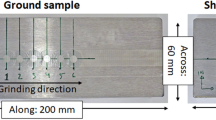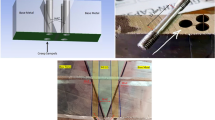Abstract
This international round robin test served to scrutinize the procedures specified in ISO/DIS 3690:2009 for determining the diffusible hydrogen content in weld metals with bcc-lattice structure. It was specifically intended to check in what respect the specifications defined in the indicated standards for specimen preparation, storage and hydrogen analysis provide comparable measurement results. The round robin test is presented comprising comparative measurements at various degassing temperatures using hot extraction techniques and a thermal conductivity detector (TCD). A major focus of this investigation was the examination of the maximum degassing temperature for analysing the diffusible hydrogen in materials with bcc-lattice structure. The analyses were performed using two different stick electrodes and three different filler wires. As a significant result it was found that no deviations or increases, were detected in the measured contents of diffusible hydrogen for the investigated degassing temperatures ranging between 45 °C and 400 °C. Hydrogen analyses for contents below HD = 1.5 ml/100 g with the hot extraction techniques in conjunction with TCD applied in this study led to considerable relative standard deviations.
Similar content being viewed by others
References
ISO/DIS 3690:2009: Welding and allied processes — Determination of hydrogen content in arc weld metal, [Revision of second edition (ISO 3690:2000)].
Kannengiesser Th., Tiersch N.: Comparative study between hot extraction methods and mercury method — A national round robin test, Doc. IIW-2136-10 (ex-doc. II-1707–09), Welding in the World, 2010, vol. 54, no. 5/6, pp. R108–R114.
ANSI/AWS A4.3-93:2006: Standard methods for determination of the diffusible hydrogen content of martensitic, bainitic, and ferritic steel weld metal produced by arc welding, AWS, Florida, USA, ISBN 0-87171-401–9.
JIS Z 3118:2007: Method for measurement of amount of hydrogen evolved from steel welds.
Gedeon S.A., Eagar T.W.: Thermochemical analysis of hydrogen absorption in welding, Welding Research Supplement, 1990, vol. 69, no. 7, pp. 264s–269s.
ISO 5725–2:2002: Accuracy (trueness and precision) of measurement methods and results — Part 2: Basic method for the determination of repeatability and reproducibility of a standard measurement method, 2002.
Author information
Authors and Affiliations
Corresponding authors
Rights and permissions
About this article
Cite this article
Kannengiesser, T., Tiersch, N. Measurements of Diffusible Hydrogen Contents at Elevated Temperatures using Different Hot Extraction Techniques — An International Round Robin Test. Weld World 54, R115–R122 (2010). https://doi.org/10.1007/BF03263497
Published:
Issue Date:
DOI: https://doi.org/10.1007/BF03263497




